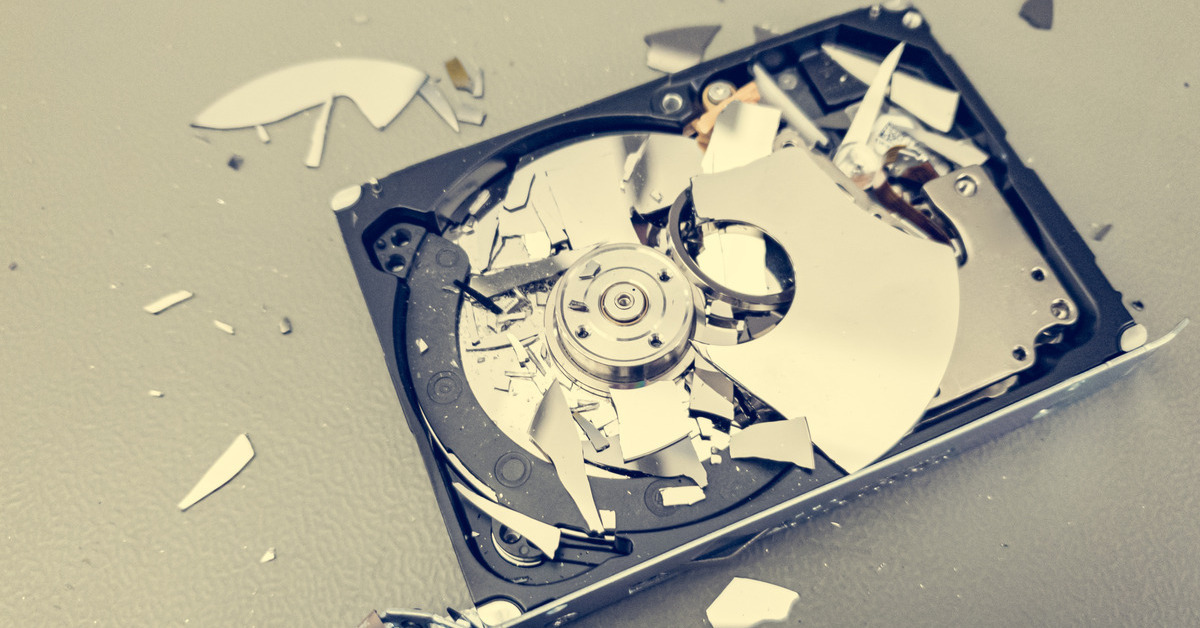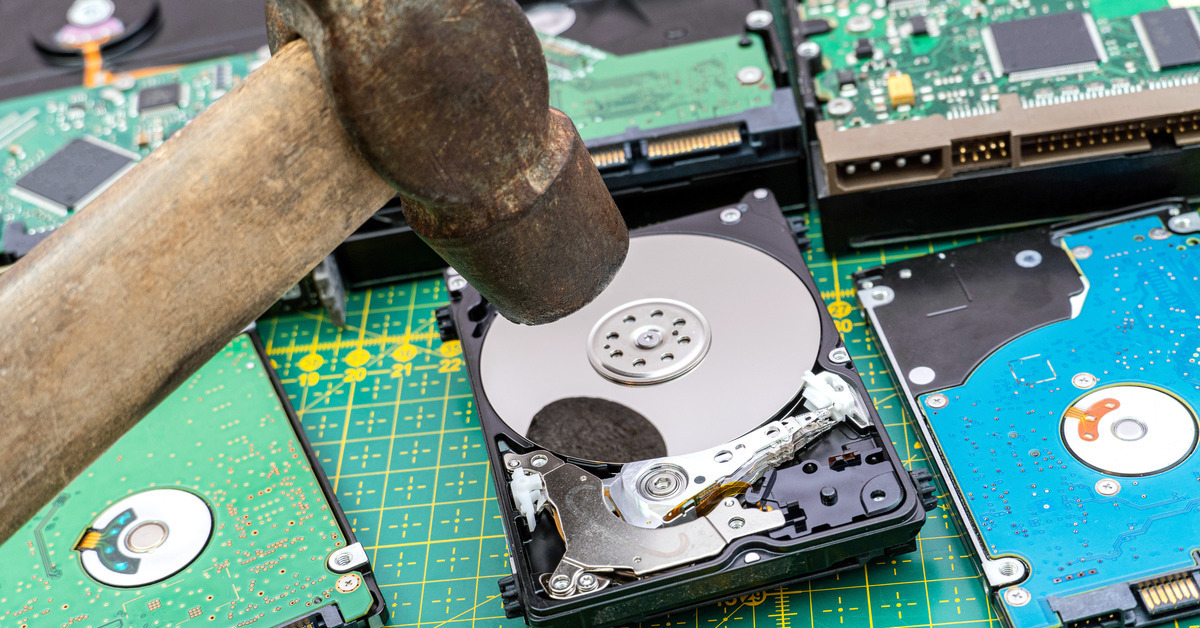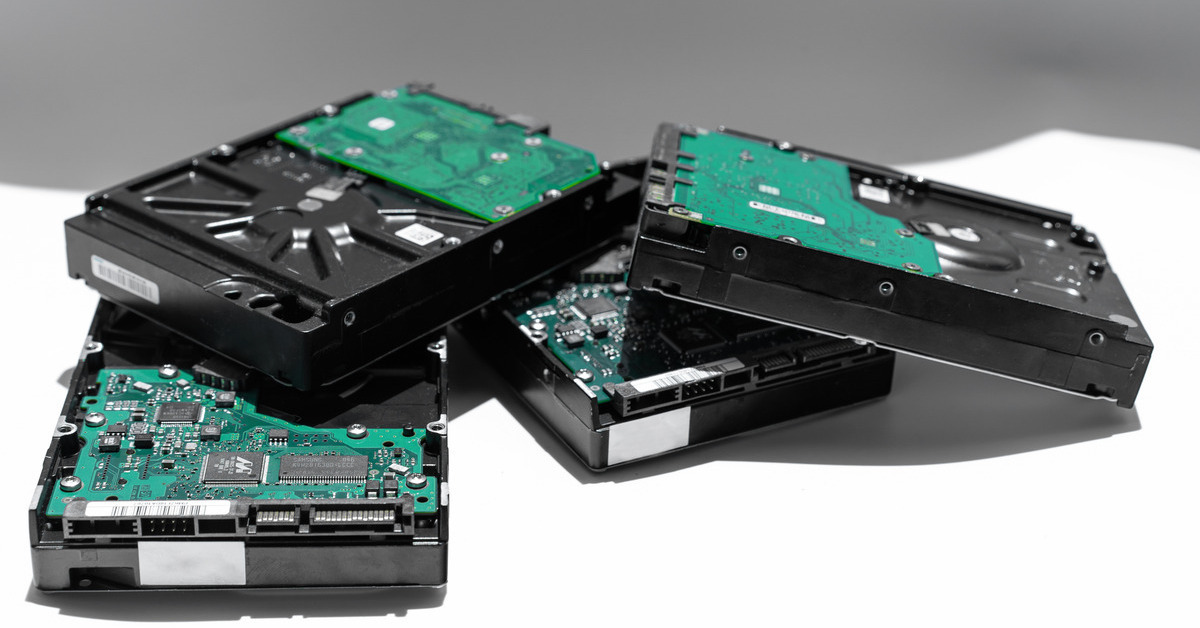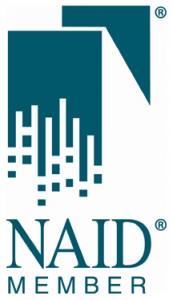
With data so ubiquitous for both professional and personal use, cybersecurity is more crucial than ever. As the number of data breaches increases and protecting sensitive information becomes increasingly important, the evolution of hard drive destruction technologies is a major topic for businesses and individuals alike.
To get a better idea of its importance, we’ll explore the evolution of hard drive destruction technologies, examining how these methods have grown to meet the demands of modern data protection.
The Untold Stories of Early Hard Drive Destruction
From Hammers to Drills
In the early days of computing, hard drive destruction methods were as rudimentary as they come. Picture a technician with a hammer or a drill manually smashing or puncturing hard drives to render them unusable. This approach, while seemingly effective, came with its limitations. Physical destruction methods often left data partially intact, posing a security risk.
Burning the Evidence
Another early method of hard drive destruction involved incineration. By melting down the hard drives, businesses aimed to ensure that data was irretrievable. However, this method was far from foolproof. Burning hard drives produced toxic fumes and waste, raising environmental concerns. Additionally, the intense heat required for complete data destruction was not always achievable, leaving some data vulnerable to recovery.
Data Wiping Missteps
Data wiping, an early digital approach to hard drive destruction, involved overwriting existing data with random patterns. While this method seemed promising, it was plagued by inefficiencies. Early data-wiping software was often unreliable, leaving remnants of original data accessible. Further, the process was slow and cumbersome, making it difficult for businesses to keep up with the increasing volume of data needing destruction.
The Digital Age and the Need for Secure Data Destruction
The Rise of Cybersecurity Threats
With the advent of the digital age came an increase in cybersecurity threats. Data breaches and hacking incidents highlighted the vulnerabilities of traditional hard drive destruction methods. Businesses began to realize that simply erasing or physically destroying hard drives was no longer enough to guarantee data security. The need for more secure, efficient data destruction techniques became evident.
Regulatory Pressure
The introduction of data privacy regulations, such as the General Data Protection Regulation (GDPR) and the California Consumer Privacy Act (CCPA), added another layer of complexity to data destruction. These regulations imposed strict requirements on businesses to protect personal information and ensure its secure disposal. Failure to comply with these regulations could result in severe penalties, pushing businesses to seek more reliable and accountable data destruction methods.
The Demand for Accountability
In response to these pressures, businesses sought certified data destruction service providers. These providers offered documented proof of compliance with regulatory standards, giving companies peace of mind that their data was being destroyed securely and responsibly. This shift marked a turning point in the evolution of hard drive destruction technologies as businesses recognized the importance of partnering with experts in the field.
Unveiling Modern Hard Drive Destruction Technologies
Physical Destruction Reimagined
Modern physical destruction techniques have come a long way since the days of hammers and drills. Today, advanced shredders and crushers are capable of pulverizing hard drives into tiny fragments for complete data destruction. These machines are designed to handle large volumes of hard drives quickly and efficiently, making them ideal for businesses with high data disposal needs.
The Power of Degaussing
Degaussing is a magnetic method of data destruction that involves exposing hard drives to a powerful electromagnetic field. This process effectively disrupts the magnetic domains on the drive, rendering the data irretrievable. Degaussers are particularly effective for magnetic storage media, such as hard disk drives (HDDs) and magnetic tapes. However, they’re not suitable for solid-state drives (SSDs), which require different destruction techniques.
Secure Data Erasure
For businesses looking to reuse or repurpose their hardware, secure data erasure provides a viable solution. This method involves using specialized software to overwrite data multiple times so it’s permanently removed. Secure data erasure is an environmentally friendly option, as it allows for the reuse of devices without compromising data security. However, you must use certified software to guarantee complete data removal.
Balancing Security and Sustainability in Hard Drive Destruction
Traditional hard drive destruction methods, such as incineration and landfill disposal, have major environmental consequences. Toxic fumes, electronic waste, and the depletion of valuable resources are just a few of the issues associated with these practices. As businesses become more environmentally conscious, the demand for sustainable hard drive destruction methods has grown.
Eco-friendly hard drive destruction methods prioritize sustainability without compromising security. For example, some companies offer recycling services that recover valuable materials from destroyed hard drives, reducing electronic waste. Others provide secure data erasure solutions that enable device reuse. By adopting these practices, businesses can minimize their environmental impact while focusing on data security.
The Role of Corporate Responsibility
Corporate responsibility plays a crucial role in the adoption of eco-friendly hard drive destruction methods. Businesses are increasingly recognizing the importance of aligning their data destruction practices with their sustainability goals. Choosing environmentally conscious service providers and promoting responsible data disposal helps companies demonstrate their commitment to data security and environmental stewardship.
The Future of Hard Drive Destruction Technology
The future of hard drive destruction technology is poised for exciting developments. Emerging trends, such as AI and automation, are set to revolutionize the field. AI-driven data destruction systems can analyze and optimize destruction processes, improving efficiency and accuracy. Automation, on the other hand, can streamline data destruction workflows, reducing human error and increasing productivity.
Quantum computing holds promise for the future of data destruction. Its ability to process vast amounts of information at unprecedented speeds could lead to groundbreaking advancements in secure data disposal. While still in its early stages, quantum computing has the potential to redefine the landscape of hard drive destruction technologies, offering new levels of security and efficiency.
Despite these thrilling prospects, future challenges in hard drive destruction remain. The rapid pace of technological advancement means that data destruction methods must continually evolve to stay ahead of emerging threats. Additionally, as data privacy regulations become more stringent, businesses must remain vigilant and compliant. Proactive investment in research and development will be essential to address these challenges.
The Road Ahead for Data Destruction
The evolution of hard drive destruction technologies is a testament to the growing importance of data security in today’s digital world. From humble beginnings to state-of-the-art modern solutions, hard drive destruction has come a long way in safeguarding sensitive information. As businesses continue to prioritize data security, they must remain proactive in adopting the latest technologies and best practices.
If you’re in need of secure computer destruction, Intellishred offers practical, affordable solutions for your organization. Our processes are safe, compliant, and efficient, giving you peace of mind when it matters most.







